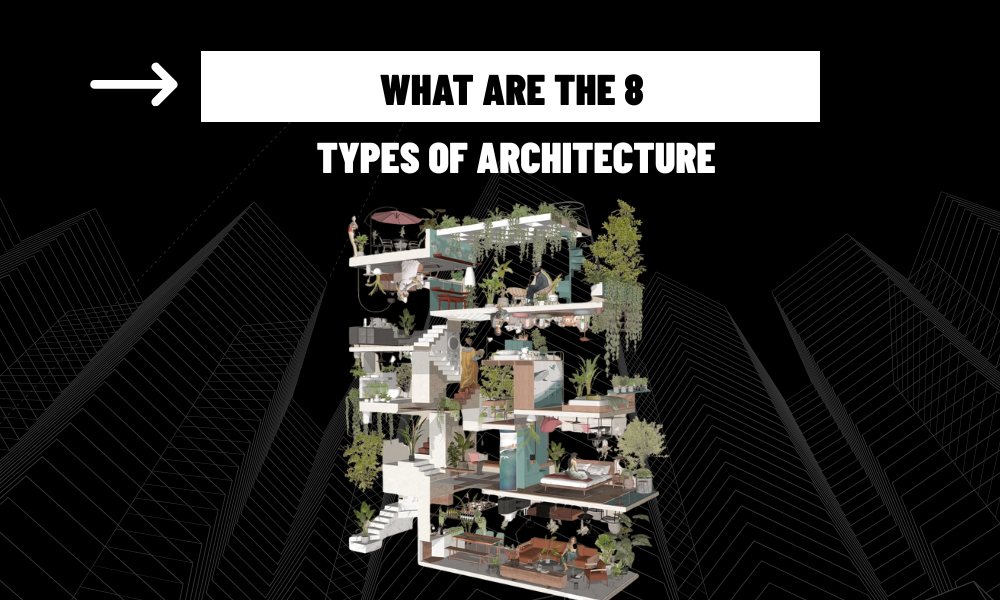Architecture is not just about aesthetics or structure — it’s about shaping human experiences, responding to environmental conditions, and facilitating the way we live, work, and move through space. When we ask, “What are the 8 types of architecture?”, we are really asking: how does design function across the full spectrum of human activity?
What Are the 8 Types of Architecture?
1. Residential Architecture: Designing Where We Live
Among the most personal forms of architecture, residential architecture focuses on homes and dwellings — from single-family houses to urban apartment complexes.
Key Characteristics:
- Emphasis on comfort, privacy, and customization
- Smart home integration: IoT devices, voice-controlled systems, automated lighting and climate control
- Passive solar design and sustainable materials
As smart living becomes standard, residential architecture increasingly blurs the line between architecture and technology, emphasizing efficiency, user experience, and wellness.
2. Commercial Architecture: Spaces for Business and Brand
Commercial architecture serves the corporate, hospitality, and retail sectors. Offices, hotels, restaurants, and shopping centers are all shaped by this typology.
Key Trends:
- Flexible workspaces for hybrid models
- Energy-efficient systems and LEED certification
- Brand-driven design that reflects company identity
The best commercial buildings are functional, intuitive, and emotionally engaging — helping businesses operate efficiently while creating a memorable experience for clients and staff.

3. Industrial Architecture: Optimizing Production and Infrastructure
Often overlooked but critically important, industrial architecture focuses on factories, warehouses, distribution centers, and data facilities.
Key Functions:
- Efficient layout for workflows and logistics
- High-load structural systems
- Increasing integration of robotics and AI in spatial planning
With the rise of e-commerce and automation, industrial architecture is rapidly evolving into a tech-forward field, prioritizing scale, adaptability, and sustainability.
4. Institutional Architecture: Designing for the Public Good
Institutional architecture encompasses buildings like schools, hospitals, museums, and libraries — public spaces that serve civic, educational, or cultural functions.
Design Considerations:
- Accessibility and inclusivity
- Space for large numbers of diverse users
- Integration of health, safety, and psychological well-being
For example, a modern school may feature collaborative learning spaces, outdoor classrooms, and optimized air quality — all central to the mission of architecture that empowers communities.
5. Religious Architecture: Sacred Spaces Across Cultures
Rooted in tradition, religious architecture reflects spiritual values and rituals. Temples, churches, mosques, and synagogues all require careful cultural sensitivity and symbolic clarity.
Evolving Trends:
- Blending heritage with modern materials
- Passive lighting and acoustic engineering
- Multi-functional community use beyond worship
These spaces must not only inspire but also welcome — supporting both spiritual and social gatherings in a meaningful architectural language.
6. Interior Architecture: Beyond Décor — Structuring the Inside
While often confused with interior design, interior architecture focuses on the layout and function of internal spaces — especially in renovation or adaptive reuse projects.
Scope of Work:
- Spatial planning and structural reconfiguration
- Integrating smart systems: lighting, HVAC, security
- Creating seamless user experiences in compact environments
In modern smart homes, interior architecture plays a critical role in integrating automation and ergonomic design into everyday life.
7. Landscape Architecture: Merging the Built with the Natural
Landscape architecture deals with outdoor spaces — from private gardens to public parks and large-scale environmental restoration.
Focus Areas:
- Green infrastructure (bioswales, rain gardens)
- Smart irrigation and lighting systems
- Climate-responsive planting and sustainable hardscapes
As cities confront heat, flooding, and biodiversity loss, landscape architecture is essential for building resilience and promoting well-being.
8. Urban Architecture (Urban Design): Shaping the City at Scale
The most macro of all typologies, urban architecture (or urban design) deals with how buildings, infrastructure, and public spaces interact within city ecosystems.
Core Elements:
- Transit-oriented development
- Mixed-use planning for density and walkability
- Integration with smart city technologies (IoT traffic systems, energy grids)
Urban architecture is increasingly collaborative, requiring input from architects, planners, technologists, and community members to build inclusive, future-ready cities.

Why These 8 Types of Architecture Matter in a Smart, Sustainable Future
When asking “What are the 8 types of architecture?”, the goal isn’t just classification — it’s comprehension. Each type represents a different function of built space, a different way architecture interacts with human life. As smart technologies and environmental challenges reshape the design landscape, understanding these categories becomes foundational for anyone building, planning, or simply inhabiting space.
Whether you’re a homeowner considering a renovation, a developer building for scale, or a designer shaping public spaces, these eight architectural disciplines offer a roadmap to purposeful, innovative design.
